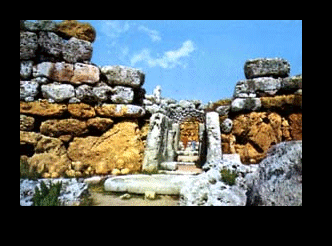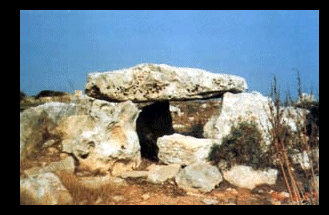Ggantija :
The Temples
Portuguese / French / Spanish / German / Italian
The
Ggantija or, as it was commonly known in the past, "The
Giants Tower", is the better preserved and by far the
most impressive prehistoric temple. it is probably the
finest of all ancient remains in these islands comparing with
SOnehenge for grandur. It was cleared round about 1826.
Though no records survived of this
operation, the most important find during this dig were the two
stone heads of statuettes, now preserved at the Gozo Museum of
Archaelogy.
Ggantija consists of two separate systems
of courtyards which, like Mnajdra Temples, do not
interconnect. They are known as teh Sough Temple which is
bigger, earlier (c. 3600 B.C.) and better preserved,
incorporating five large apses and the North Temple  which is smaller and a later
addition (c. 3000 B.C.) in a 4-apse form. The great court
of teh South Temple measures 23 metres from apse to apse and the
height of the wall here is preserved to eight metres, the highest
in all the temples. Here one notices how the successive
courses of stone draw in the manner of corbelling, htough it is
not possible that the aperture at the top was roofed with
stones. The arch had not yet been known in building
construction and the span of the apses here is quite large for
any conceivable stone roofing. Wood or hides might
originally have been used as roofing material.
which is smaller and a later
addition (c. 3000 B.C.) in a 4-apse form. The great court
of teh South Temple measures 23 metres from apse to apse and the
height of the wall here is preserved to eight metres, the highest
in all the temples. Here one notices how the successive
courses of stone draw in the manner of corbelling, htough it is
not possible that the aperture at the top was roofed with
stones. The arch had not yet been known in building
construction and the span of the apses here is quite large for
any conceivable stone roofing. Wood or hides might
originally have been used as roofing material.
The Gigantic rocks must be several tons
in weight, those of the outer wall reaching as high as six
meters. There are various theories as to how the people of those
days were able to move them with the primitive tools of the
period. According to an old myth a female giant called
"Sunsuna" carried the rocks on her head from Ta'Cenc
(on the other side of the island).
Two kinds of stone had been used in the
construction "tal-franka", the soft stone mainly
used inside as portals and floor slabs, and "tal-qawwi",
the hard stone which is mostly used for the general construction
of the walls.
The interior of the walls was plastered
and painted with red ochre. Trace of this have been
found. The huge megaliths, forming the outer wall (the
largest weighing several tons) were built alternatively, one
horiszontally and one upright. The space between the inner
and outer walls is filled with rubble and earth. It is such
a system which has given the Ggantija the stability to withstand
the depredations fo over 5000 years. The floor is partly
covered with soft stone slabs and partly with "torba",
or beaten earth. Spiral and pitted designs decorate some of
teh soft stone slabs. Ore can hardly see the spirals today
but considering their good state of preservation when the site
was uncovered, this indicates that the temples had some kind of
roofing protection during their use.
Some Archeologists assume that there
might be an underground temple below Ggantija similar to the
Hypogeum uncovered in Malta, a hypothesis which has not yet been
verified. Apart from Ggantija there are other interesting
testimonies from prehistoric times, for example: the
"Menhir" of Qala, Santa Verna, a smaller Temple also
close to Xaghra, and the Temples of Tal-Qighan and Ta' Marziena
in Sannat.
times, for example: the
"Menhir" of Qala, Santa Verna, a smaller Temple also
close to Xaghra, and the Temples of Tal-Qighan and Ta' Marziena
in Sannat.
In Gozo close to Ta' Cenc one can also observe what are thought
to be cart-tracks although their origin has yet to be
established.
Back to Main Page
 which is smaller and a later
addition (c. 3000 B.C.) in a 4-apse form. The great court
of teh South Temple measures 23 metres from apse to apse and the
height of the wall here is preserved to eight metres, the highest
in all the temples. Here one notices how the successive
courses of stone draw in the manner of corbelling, htough it is
not possible that the aperture at the top was roofed with
stones. The arch had not yet been known in building
construction and the span of the apses here is quite large for
any conceivable stone roofing. Wood or hides might
originally have been used as roofing material.
which is smaller and a later
addition (c. 3000 B.C.) in a 4-apse form. The great court
of teh South Temple measures 23 metres from apse to apse and the
height of the wall here is preserved to eight metres, the highest
in all the temples. Here one notices how the successive
courses of stone draw in the manner of corbelling, htough it is
not possible that the aperture at the top was roofed with
stones. The arch had not yet been known in building
construction and the span of the apses here is quite large for
any conceivable stone roofing. Wood or hides might
originally have been used as roofing material.  times, for example: the
"Menhir" of Qala, Santa Verna, a smaller Temple also
close to Xaghra, and the Temples of Tal-Qighan and Ta' Marziena
in Sannat.
times, for example: the
"Menhir" of Qala, Santa Verna, a smaller Temple also
close to Xaghra, and the Temples of Tal-Qighan and Ta' Marziena
in Sannat.